University Business Report: Strategic Planning for Coca-Cola Company
VerifiedAdded on 2020/03/23
|6
|1410
|47
Report
AI Summary
This report provides a strategic analysis of the Coca-Cola Company, examining its market position, competitive advantages, and strategic planning. It delves into the history of Coca-Cola's competition with Pepsi, highlighting their marketing strategies and brand campaigns. The report applies Michael Porter's concepts to analyze the competitive forces within the soft drink industry, including customers, suppliers, potential entrants, and substitute products. It explores Coca-Cola's successful market positioning, emphasizing factors like price, packaging, promotion, and distribution. The report identifies Coca-Cola's competitive advantages, such as market leadership and customer relationships, and assesses the bargaining power of buyers and suppliers. It also considers the threats from new entrants and substitute products. The report concludes by emphasizing the importance of continuous improvement, new market exploration, and effective communication to maintain and enhance Coca-Cola's market position. The importance of quality standards and a sustainable supply chain are also highlighted.
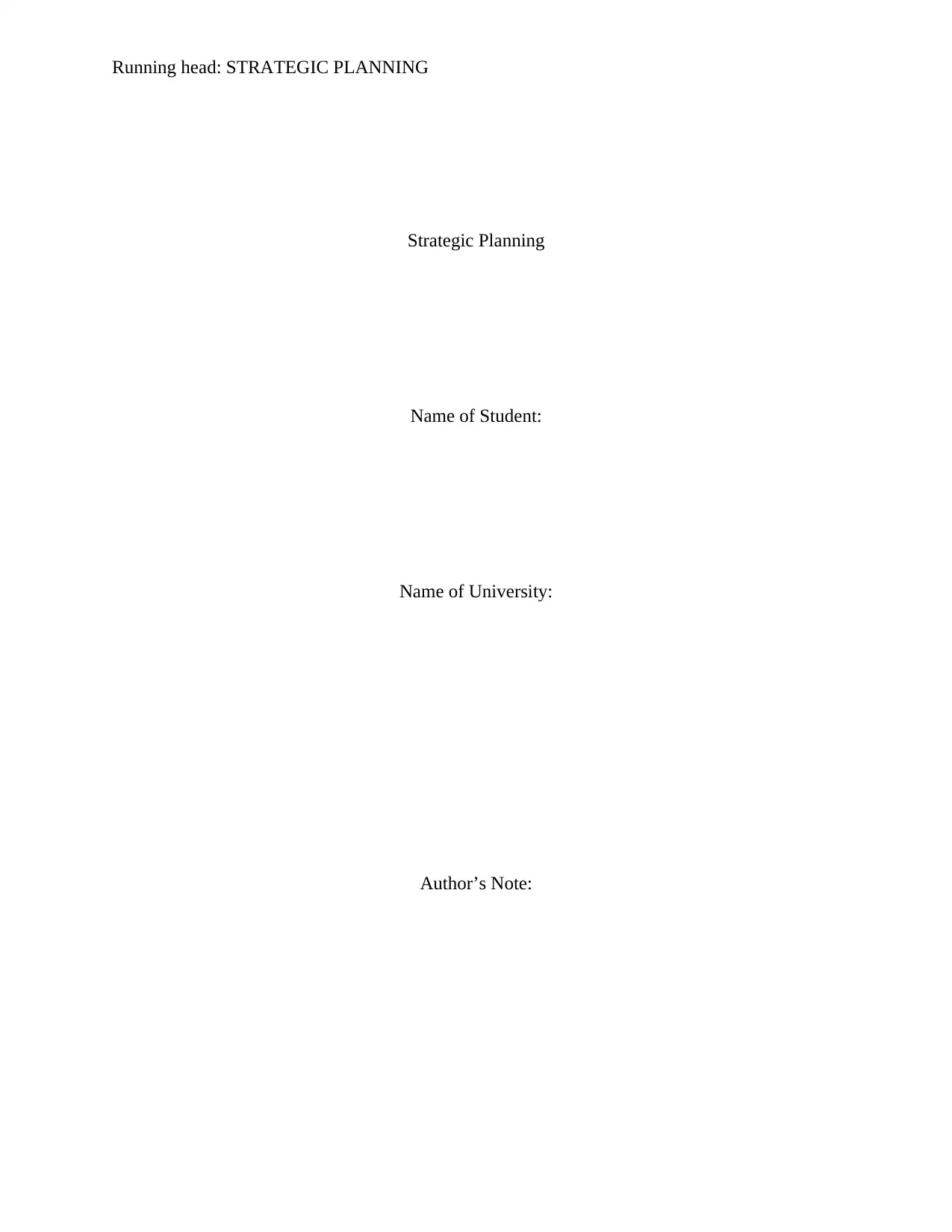
Running head: STRATEGIC PLANNING
Strategic Planning
Name of Student:
Name of University:
Author’s Note:
Strategic Planning
Name of Student:
Name of University:
Author’s Note:
Paraphrase This Document
Need a fresh take? Get an instant paraphrase of this document with our AI Paraphraser
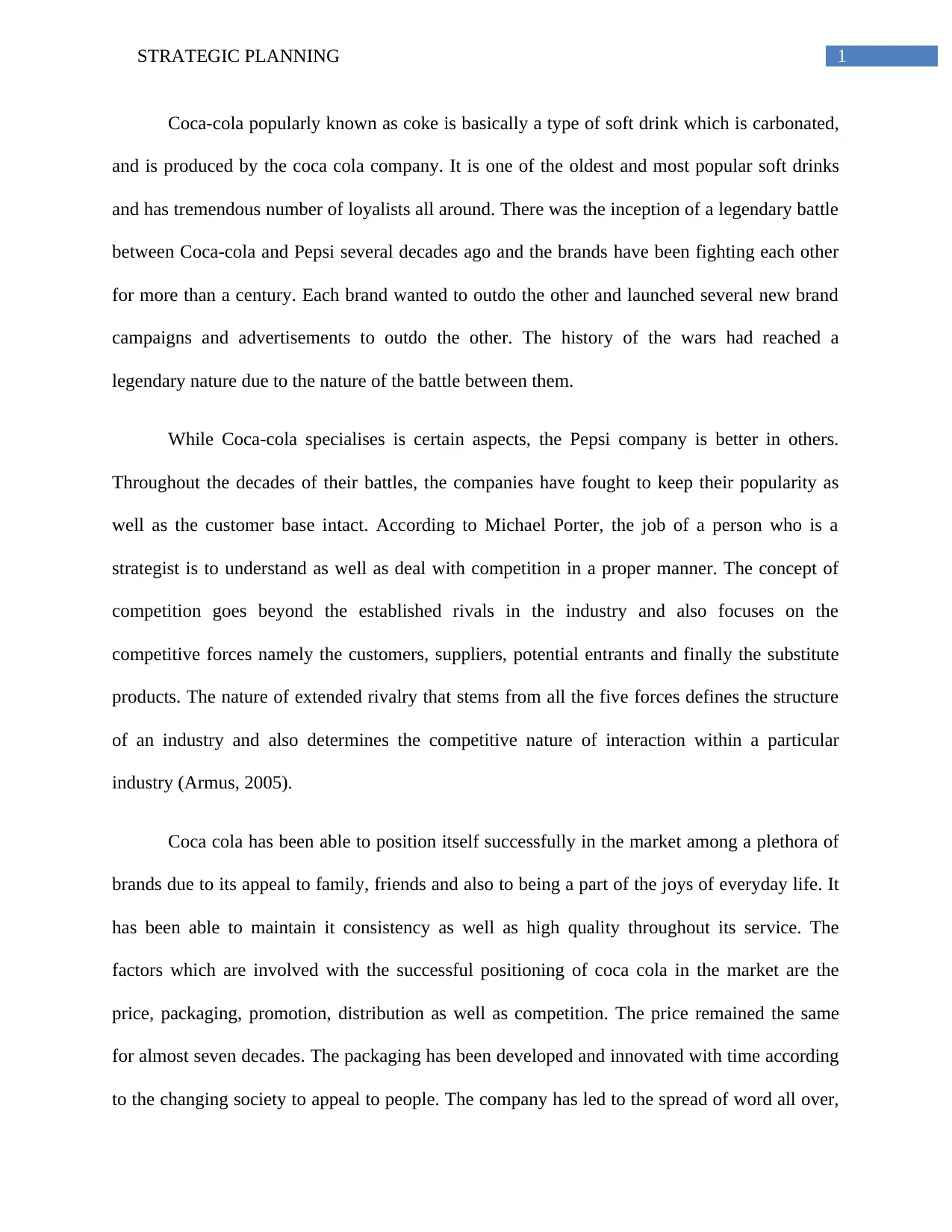
1STRATEGIC PLANNING
Coca-cola popularly known as coke is basically a type of soft drink which is carbonated,
and is produced by the coca cola company. It is one of the oldest and most popular soft drinks
and has tremendous number of loyalists all around. There was the inception of a legendary battle
between Coca-cola and Pepsi several decades ago and the brands have been fighting each other
for more than a century. Each brand wanted to outdo the other and launched several new brand
campaigns and advertisements to outdo the other. The history of the wars had reached a
legendary nature due to the nature of the battle between them.
While Coca-cola specialises is certain aspects, the Pepsi company is better in others.
Throughout the decades of their battles, the companies have fought to keep their popularity as
well as the customer base intact. According to Michael Porter, the job of a person who is a
strategist is to understand as well as deal with competition in a proper manner. The concept of
competition goes beyond the established rivals in the industry and also focuses on the
competitive forces namely the customers, suppliers, potential entrants and finally the substitute
products. The nature of extended rivalry that stems from all the five forces defines the structure
of an industry and also determines the competitive nature of interaction within a particular
industry (Armus, 2005).
Coca cola has been able to position itself successfully in the market among a plethora of
brands due to its appeal to family, friends and also to being a part of the joys of everyday life. It
has been able to maintain it consistency as well as high quality throughout its service. The
factors which are involved with the successful positioning of coca cola in the market are the
price, packaging, promotion, distribution as well as competition. The price remained the same
for almost seven decades. The packaging has been developed and innovated with time according
to the changing society to appeal to people. The company has led to the spread of word all over,
Coca-cola popularly known as coke is basically a type of soft drink which is carbonated,
and is produced by the coca cola company. It is one of the oldest and most popular soft drinks
and has tremendous number of loyalists all around. There was the inception of a legendary battle
between Coca-cola and Pepsi several decades ago and the brands have been fighting each other
for more than a century. Each brand wanted to outdo the other and launched several new brand
campaigns and advertisements to outdo the other. The history of the wars had reached a
legendary nature due to the nature of the battle between them.
While Coca-cola specialises is certain aspects, the Pepsi company is better in others.
Throughout the decades of their battles, the companies have fought to keep their popularity as
well as the customer base intact. According to Michael Porter, the job of a person who is a
strategist is to understand as well as deal with competition in a proper manner. The concept of
competition goes beyond the established rivals in the industry and also focuses on the
competitive forces namely the customers, suppliers, potential entrants and finally the substitute
products. The nature of extended rivalry that stems from all the five forces defines the structure
of an industry and also determines the competitive nature of interaction within a particular
industry (Armus, 2005).
Coca cola has been able to position itself successfully in the market among a plethora of
brands due to its appeal to family, friends and also to being a part of the joys of everyday life. It
has been able to maintain it consistency as well as high quality throughout its service. The
factors which are involved with the successful positioning of coca cola in the market are the
price, packaging, promotion, distribution as well as competition. The price remained the same
for almost seven decades. The packaging has been developed and innovated with time according
to the changing society to appeal to people. The company has led to the spread of word all over,
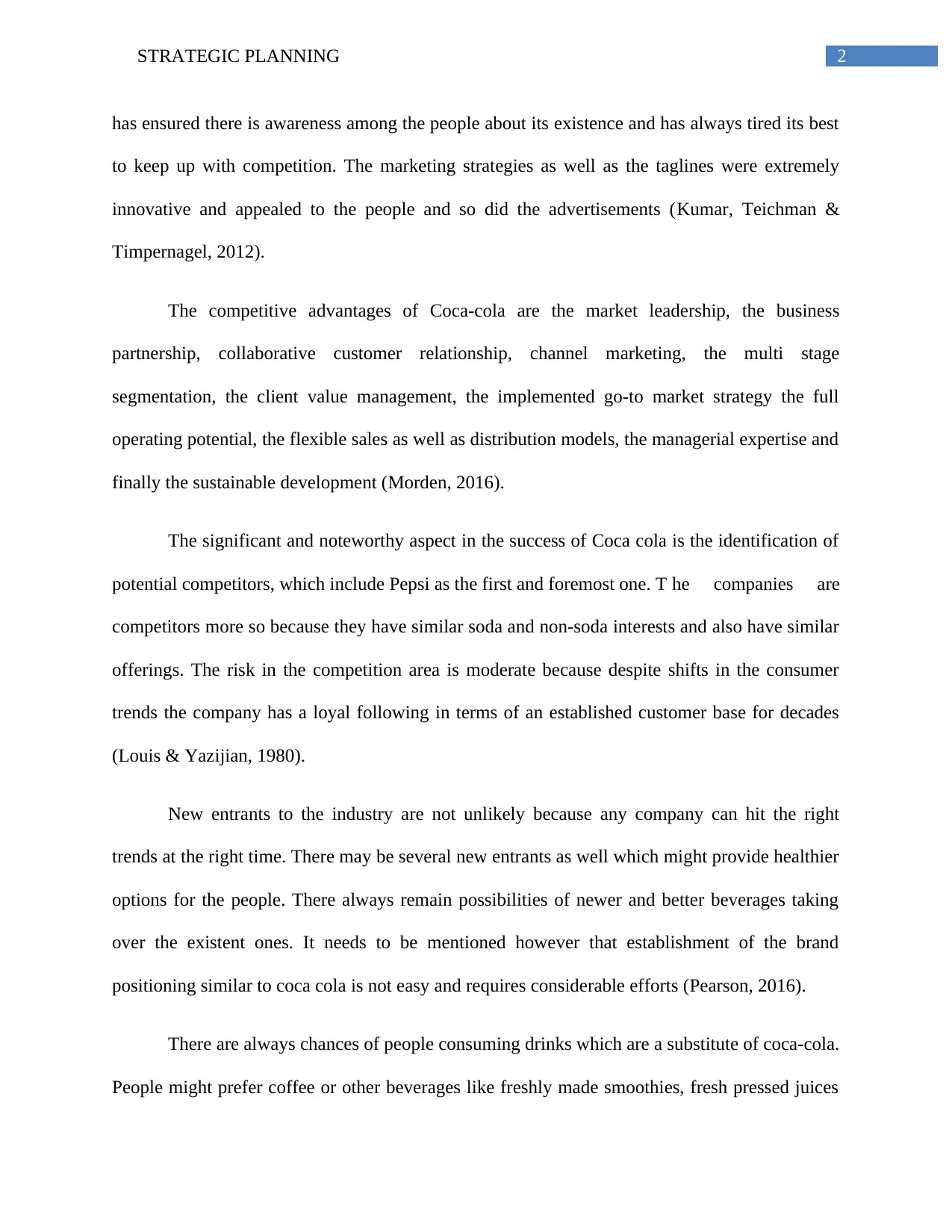
2STRATEGIC PLANNING
has ensured there is awareness among the people about its existence and has always tired its best
to keep up with competition. The marketing strategies as well as the taglines were extremely
innovative and appealed to the people and so did the advertisements (Kumar, Teichman &
Timpernagel, 2012).
The competitive advantages of Coca-cola are the market leadership, the business
partnership, collaborative customer relationship, channel marketing, the multi stage
segmentation, the client value management, the implemented go-to market strategy the full
operating potential, the flexible sales as well as distribution models, the managerial expertise and
finally the sustainable development (Morden, 2016).
The significant and noteworthy aspect in the success of Coca cola is the identification of
potential competitors, which include Pepsi as the first and foremost one. T he companies are
competitors more so because they have similar soda and non-soda interests and also have similar
offerings. The risk in the competition area is moderate because despite shifts in the consumer
trends the company has a loyal following in terms of an established customer base for decades
(Louis & Yazijian, 1980).
New entrants to the industry are not unlikely because any company can hit the right
trends at the right time. There may be several new entrants as well which might provide healthier
options for the people. There always remain possibilities of newer and better beverages taking
over the existent ones. It needs to be mentioned however that establishment of the brand
positioning similar to coca cola is not easy and requires considerable efforts (Pearson, 2016).
There are always chances of people consuming drinks which are a substitute of coca-cola.
People might prefer coffee or other beverages like freshly made smoothies, fresh pressed juices
has ensured there is awareness among the people about its existence and has always tired its best
to keep up with competition. The marketing strategies as well as the taglines were extremely
innovative and appealed to the people and so did the advertisements (Kumar, Teichman &
Timpernagel, 2012).
The competitive advantages of Coca-cola are the market leadership, the business
partnership, collaborative customer relationship, channel marketing, the multi stage
segmentation, the client value management, the implemented go-to market strategy the full
operating potential, the flexible sales as well as distribution models, the managerial expertise and
finally the sustainable development (Morden, 2016).
The significant and noteworthy aspect in the success of Coca cola is the identification of
potential competitors, which include Pepsi as the first and foremost one. T he companies are
competitors more so because they have similar soda and non-soda interests and also have similar
offerings. The risk in the competition area is moderate because despite shifts in the consumer
trends the company has a loyal following in terms of an established customer base for decades
(Louis & Yazijian, 1980).
New entrants to the industry are not unlikely because any company can hit the right
trends at the right time. There may be several new entrants as well which might provide healthier
options for the people. There always remain possibilities of newer and better beverages taking
over the existent ones. It needs to be mentioned however that establishment of the brand
positioning similar to coca cola is not easy and requires considerable efforts (Pearson, 2016).
There are always chances of people consuming drinks which are a substitute of coca-cola.
People might prefer coffee or other beverages like freshly made smoothies, fresh pressed juices
⊘ This is a preview!⊘
Do you want full access?
Subscribe today to unlock all pages.

Trusted by 1+ million students worldwide
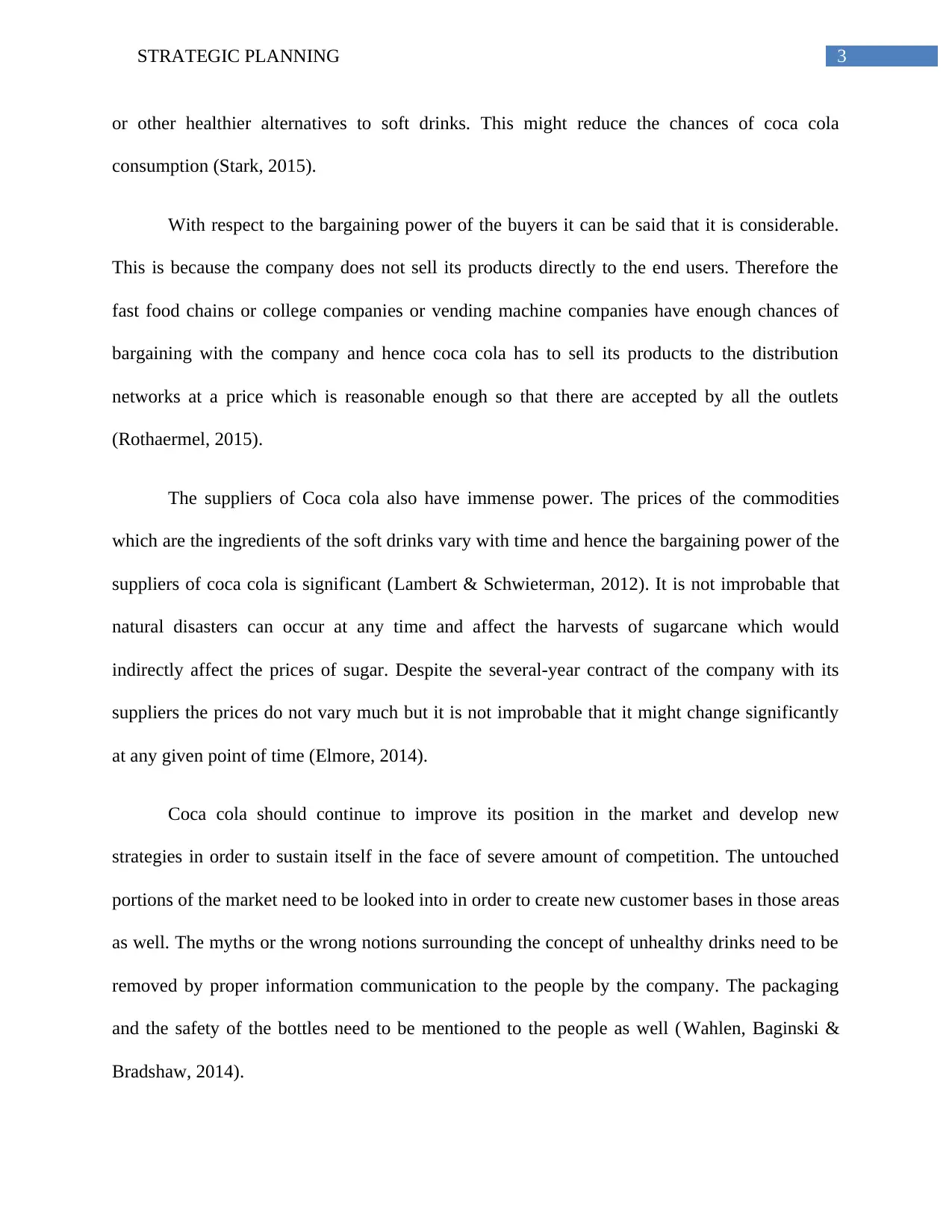
3STRATEGIC PLANNING
or other healthier alternatives to soft drinks. This might reduce the chances of coca cola
consumption (Stark, 2015).
With respect to the bargaining power of the buyers it can be said that it is considerable.
This is because the company does not sell its products directly to the end users. Therefore the
fast food chains or college companies or vending machine companies have enough chances of
bargaining with the company and hence coca cola has to sell its products to the distribution
networks at a price which is reasonable enough so that there are accepted by all the outlets
(Rothaermel, 2015).
The suppliers of Coca cola also have immense power. The prices of the commodities
which are the ingredients of the soft drinks vary with time and hence the bargaining power of the
suppliers of coca cola is significant (Lambert & Schwieterman, 2012). It is not improbable that
natural disasters can occur at any time and affect the harvests of sugarcane which would
indirectly affect the prices of sugar. Despite the several-year contract of the company with its
suppliers the prices do not vary much but it is not improbable that it might change significantly
at any given point of time (Elmore, 2014).
Coca cola should continue to improve its position in the market and develop new
strategies in order to sustain itself in the face of severe amount of competition. The untouched
portions of the market need to be looked into in order to create new customer bases in those areas
as well. The myths or the wrong notions surrounding the concept of unhealthy drinks need to be
removed by proper information communication to the people by the company. The packaging
and the safety of the bottles need to be mentioned to the people as well ( Wahlen, Baginski &
Bradshaw, 2014).
or other healthier alternatives to soft drinks. This might reduce the chances of coca cola
consumption (Stark, 2015).
With respect to the bargaining power of the buyers it can be said that it is considerable.
This is because the company does not sell its products directly to the end users. Therefore the
fast food chains or college companies or vending machine companies have enough chances of
bargaining with the company and hence coca cola has to sell its products to the distribution
networks at a price which is reasonable enough so that there are accepted by all the outlets
(Rothaermel, 2015).
The suppliers of Coca cola also have immense power. The prices of the commodities
which are the ingredients of the soft drinks vary with time and hence the bargaining power of the
suppliers of coca cola is significant (Lambert & Schwieterman, 2012). It is not improbable that
natural disasters can occur at any time and affect the harvests of sugarcane which would
indirectly affect the prices of sugar. Despite the several-year contract of the company with its
suppliers the prices do not vary much but it is not improbable that it might change significantly
at any given point of time (Elmore, 2014).
Coca cola should continue to improve its position in the market and develop new
strategies in order to sustain itself in the face of severe amount of competition. The untouched
portions of the market need to be looked into in order to create new customer bases in those areas
as well. The myths or the wrong notions surrounding the concept of unhealthy drinks need to be
removed by proper information communication to the people by the company. The packaging
and the safety of the bottles need to be mentioned to the people as well ( Wahlen, Baginski &
Bradshaw, 2014).
Paraphrase This Document
Need a fresh take? Get an instant paraphrase of this document with our AI Paraphraser

4STRATEGIC PLANNING
The company has to employ the procedures of the highest quality and also to establish
standards guaranteeing the production of a standard product meeting the expectations of the
customers. The process also involves continued emphasis on getting the correct standards of
quality and seeking ways for the improvement of performance. It is quite difficult for other
companies to keep up with the level of coca cola and take the place which has already been
established by the company in the market. An efficient supply chain and emphasis on sustainable
development has led the company to reach a place in the competitive market.
The company has to employ the procedures of the highest quality and also to establish
standards guaranteeing the production of a standard product meeting the expectations of the
customers. The process also involves continued emphasis on getting the correct standards of
quality and seeking ways for the improvement of performance. It is quite difficult for other
companies to keep up with the level of coca cola and take the place which has already been
established by the company in the market. An efficient supply chain and emphasis on sustainable
development has led the company to reach a place in the competitive market.
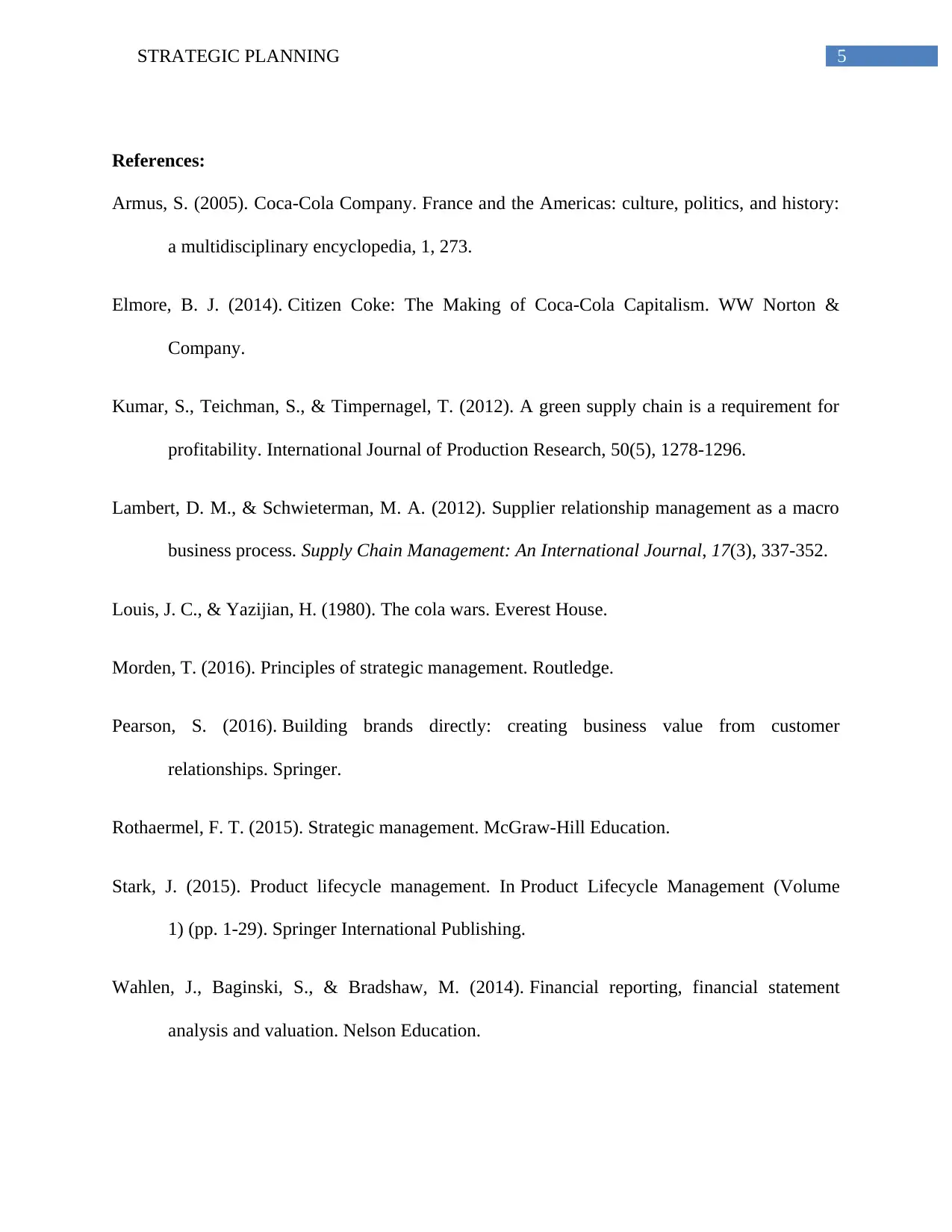
5STRATEGIC PLANNING
References:
Armus, S. (2005). Coca-Cola Company. France and the Americas: culture, politics, and history:
a multidisciplinary encyclopedia, 1, 273.
Elmore, B. J. (2014). Citizen Coke: The Making of Coca-Cola Capitalism. WW Norton &
Company.
Kumar, S., Teichman, S., & Timpernagel, T. (2012). A green supply chain is a requirement for
profitability. International Journal of Production Research, 50(5), 1278-1296.
Lambert, D. M., & Schwieterman, M. A. (2012). Supplier relationship management as a macro
business process. Supply Chain Management: An International Journal, 17(3), 337-352.
Louis, J. C., & Yazijian, H. (1980). The cola wars. Everest House.
Morden, T. (2016). Principles of strategic management. Routledge.
Pearson, S. (2016). Building brands directly: creating business value from customer
relationships. Springer.
Rothaermel, F. T. (2015). Strategic management. McGraw-Hill Education.
Stark, J. (2015). Product lifecycle management. In Product Lifecycle Management (Volume
1) (pp. 1-29). Springer International Publishing.
Wahlen, J., Baginski, S., & Bradshaw, M. (2014). Financial reporting, financial statement
analysis and valuation. Nelson Education.
References:
Armus, S. (2005). Coca-Cola Company. France and the Americas: culture, politics, and history:
a multidisciplinary encyclopedia, 1, 273.
Elmore, B. J. (2014). Citizen Coke: The Making of Coca-Cola Capitalism. WW Norton &
Company.
Kumar, S., Teichman, S., & Timpernagel, T. (2012). A green supply chain is a requirement for
profitability. International Journal of Production Research, 50(5), 1278-1296.
Lambert, D. M., & Schwieterman, M. A. (2012). Supplier relationship management as a macro
business process. Supply Chain Management: An International Journal, 17(3), 337-352.
Louis, J. C., & Yazijian, H. (1980). The cola wars. Everest House.
Morden, T. (2016). Principles of strategic management. Routledge.
Pearson, S. (2016). Building brands directly: creating business value from customer
relationships. Springer.
Rothaermel, F. T. (2015). Strategic management. McGraw-Hill Education.
Stark, J. (2015). Product lifecycle management. In Product Lifecycle Management (Volume
1) (pp. 1-29). Springer International Publishing.
Wahlen, J., Baginski, S., & Bradshaw, M. (2014). Financial reporting, financial statement
analysis and valuation. Nelson Education.
⊘ This is a preview!⊘
Do you want full access?
Subscribe today to unlock all pages.

Trusted by 1+ million students worldwide
1 out of 6
Related Documents
Your All-in-One AI-Powered Toolkit for Academic Success.
+13062052269
info@desklib.com
Available 24*7 on WhatsApp / Email
![[object Object]](/_next/static/media/star-bottom.7253800d.svg)
Unlock your academic potential
Copyright © 2020–2025 A2Z Services. All Rights Reserved. Developed and managed by ZUCOL.





